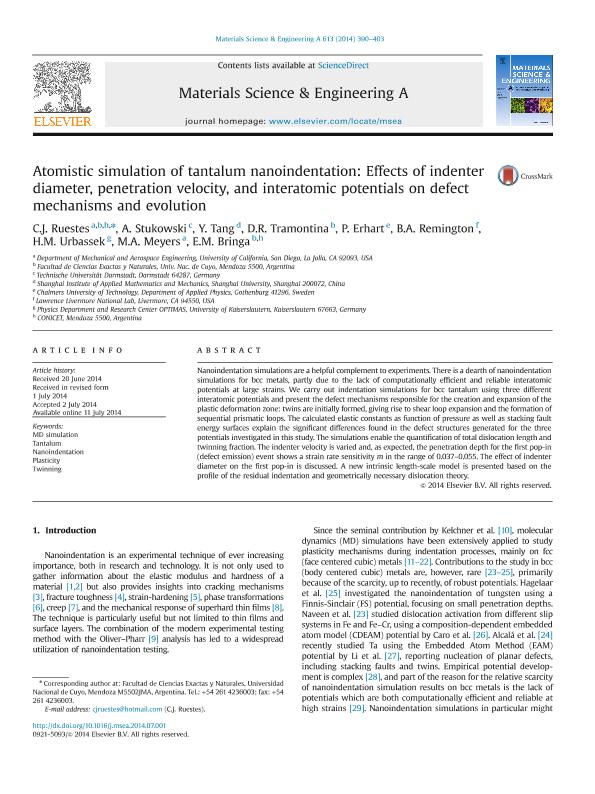Artículo
Atomistic simulation of tantalum nanoindentation: effects of indenter diameter, penetration velocity, and interatomic potentials on defect mechanisms and evolution
Ruestes, Carlos Javier ; Stukowski, Alexander; Tang, Yizhe; Tramontina Videla, Diego Ramiro
; Stukowski, Alexander; Tang, Yizhe; Tramontina Videla, Diego Ramiro ; Erhart, Paul; Urbassek, Herbery; Remington, Bruce A.; Meyers, Marc A.; Bringa, Eduardo Marcial
; Erhart, Paul; Urbassek, Herbery; Remington, Bruce A.; Meyers, Marc A.; Bringa, Eduardo Marcial
 ; Stukowski, Alexander; Tang, Yizhe; Tramontina Videla, Diego Ramiro
; Stukowski, Alexander; Tang, Yizhe; Tramontina Videla, Diego Ramiro ; Erhart, Paul; Urbassek, Herbery; Remington, Bruce A.; Meyers, Marc A.; Bringa, Eduardo Marcial
; Erhart, Paul; Urbassek, Herbery; Remington, Bruce A.; Meyers, Marc A.; Bringa, Eduardo Marcial
Fecha de publicación:
07/2014
Editorial:
Elsevier Science Sa
Revista:
Materials Science and Engineering A: Structural Materials: Properties, Microstructure and Processing
ISSN:
0921-5093
Idioma:
Inglés
Tipo de recurso:
Artículo publicado
Clasificación temática:
Resumen
Nanoindentation simulations are a helpful complement to experiments. There is a dearth of nanoindentation simulations for bcc metals, partly due to the lack of computationally efficient and reliable interatomic potentials at large strains. We carry out indentation simulations for bcc tantalum using three different interatomic potentials and present the defect mechanisms responsible for the creation and expansion of the plastic deformation zone: twins are initially formed, giving rise to shear loop expansion and the formation of sequential prismatic loops. The calculated elastic constants as function of pressure as well as stacking fault energy surfaces explain the significant differences found in the defect structures generated for the three potentials investigated in this study. The simulations enable the quantification of total dislocation length and twinning fraction. The indenter velocity is varied and, as expected, the penetration depth for the first pop-in (defect emission) event shows a strain rate sensitivity m in the range of 0.037-0.055. The effect of indenter diameter on the first pop-in is discussed. A new intrinsic length-scale model is presented based on the profile of the residual indentation and geometrically-necessary dislocation theory.
Palabras clave:
Md Simulation
,
Tantalum
,
Nanoindentation
,
Plasticity
,
Twinning
Archivos asociados
Licencia
Identificadores
Colecciones
Articulos(CCT - MENDOZA)
Articulos de CTRO.CIENTIFICO TECNOL.CONICET - MENDOZA
Articulos de CTRO.CIENTIFICO TECNOL.CONICET - MENDOZA
Citación
Ruestes, Carlos Javier; Stukowski, Alexander; Tang, Yizhe; Tramontina Videla, Diego Ramiro; Erhart, Paul; et al.; Atomistic simulation of tantalum nanoindentation: effects of indenter diameter, penetration velocity, and interatomic potentials on defect mechanisms and evolution; Elsevier Science Sa; Materials Science and Engineering A: Structural Materials: Properties, Microstructure and Processing; 613; 7-2014; 390-403
Compartir
Altmétricas



